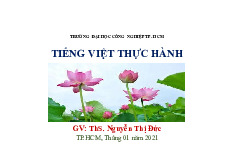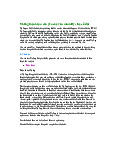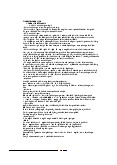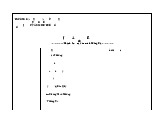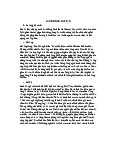


Preview text:
3 Career-Building Strategies for an Increasingly Complex World of Work
In today’s dynamic work landscape, driven by rapid technological advancements and
a global shift towards more fluid and flexible work arrangements, the importance of
cultivating a learning mindset, building a diverse skill set, adopting a flexible work
ethic, and prioritizing work-life harmony has never been more pronounced. These
elements are foundational, the very minimum required to navigate the complexities
of modern work. However, simply possessing these qualities is no longer sufficient to
ensure success. The nature of work has evolved, and so too have the strategies we
must employ to thrive in this new era. The emergence of the new world of work that
includes project-based freelance work, remote work, digital-collaboration platforms,
and AI, or what we call the open-talent economy, has fundamentally altered how
work is performed, valued, and conceptualized.
This evolution demands a significant shift in how individuals approach their careers
and how organizations structure their workforces. The traditional model of long-term
employment, characterized by fixed roles within a hierarchical organization, is being
supplemented — and in some cases, replaced — by more fluid and dynamic forms of
engagement. This includes project-based work, freelancing, and roles that are
increasingly defined by outcomes rather than hours spent at a desk. In response to
these changes, people must rethink their approach to work. It’s not just about what
you know or how hard you work but how adaptable you are, how quickly you can
learn new skills, how effectively you can apply those skills in varied and changing
contexts, and how well you can collaborate with external teams and AI. Success in
this new world requires not only recognizing these shifts but actively strategizing to
leverage them to your advantage.
To navigate this new world of open work successfully, it’s crucial to adopt three key
strategies: leveraging digital platforms and networks, using open talent and
freelancers as a secret weapon, and harnessing the power of AI to augment your
capabilities. These strategies are not just about staying relevant. They’re about seizing
the opportunities presented by this shift to enhance productivity, foster innovation,
and achieve a more fulfilling and balanced professional life. In this article, I will delve
deeper into each of these strategies, offering practical advice on how to implement
them effectively. As the work landscape continues to evolve, embracing these
strategies will be critical for individuals looking to thrive in the age of AI and open work.
Leverage Digital Platforms and Networks
In an era where your digital footprint often serves as your first impression, leveraging
online platforms and professional networks is crucial. These digital arenas allow you
not only to showcase your expertise and achievements but also function as vital
connectors to the global-talent ecosystem. Here’s how to navigate this digital landscape effectively:
Establish a Strong Online Presence: Create professional profiles on platforms
like LinkedIn, GitHub, or other industry-specific networks. Keep your profiles
updated with your latest skills, projects, and accomplishments. This visibility ensures
you’re discoverable to potential collaborators, employers, or clients who are searching
for the unique skill set you offer. As is often said, you have to build your own brand.
Engage with Professional Communities: Actively participate in online forums,
groups, and discussions that align with your field. By sharing your knowledge,
seeking advice, and connecting with peers and leaders, you create a network of
professional relationships that can lead to opportunities and collaborations.
Showcase Your Work: Places such as LinkedIn for engagement, GitHub for code,
or Medium for articles and thought leadership provide a space to publish and
highlight your projects and contributions. This not only serves as a portfolio to attract
freelance projects or job offers but also demonstrates your capabilities and thought
leadership to a wider audience.
Use Open Talent and Freelancers as Your “Secret Sauce”
Adopting a strategic approach to incorporating open talent and freelancers into your
work processes, whether you are still working for a company full-time or are a
freelancer doing project work, can significantly enhance your productivity and
capability. As businesses strive to be more agile and responsive, you have to do the
same to stay ahead. The ability to tap into a global talent pool for specialized skills
and expertise on demand becomes a competitive advantage. Here’s how to make the most of this strategy:
Identify Tasks for Delegation: Analyze your workload to determine which tasks
or projects could be more efficiently completed by freelancers. This could include
finding help to create a deck, write a proposal or create and analyze databases.
Focusing your energies on core competencies while outsourcing specialized or time- consuming tasks.
Utilize Freelance Platforms: Platforms like Torc, Graphite, or Andela are
valuable resources for finding and engaging skilled freelancers. The right platform
can help create clear project scopes, deliverables, and timelines are essential to
ensure a smooth collaboration process.
Foster Long-Term Relationships: Create your own bench by developing ongoing
relationships with reliable freelancers not only streamlines the process for future
projects but also builds a network of trusted talent you can depend on to deliver high- quality work.
Harness the Power of AI to Become Super-Human
The final strategy revolves around harnessing the power of artificial intelligence to
augment your capabilities, improve productivity, and make more informed decisions.
As AI continues to evolve, understanding and integrating AI tools into your work
processes can significantly impact your efficiency and effectiveness. Here’s how to leverage AI:
Automate Routine Tasks: AI-powered tools can handle repetitive tasks such as
customer service inquiries or data entry, freeing you to focus on higher-level strategy and creativity.
Enhance Decision Making: AI’s ability to analyze large datasets and identify
patterns can provide valuable insights for decision-making. The right tool can
transform data into actionable intelligence.
Stay Informed and Upskill: The landscape of AI is rapidly changing. Continually
learning about new AI technologies and tools relevant to your field is crucial.
Engaging in webinars, online courses, and workshops ensures you stay ahead of the
curve and can effectively integrate AI into your workflows.
By embracing these strategies and executing on the steps, aspiring professionals can
more effectively navigate the complexities of the modern work environment. This
multi-pronged approach not only facilitates personal and organizational growth but
also positions you to thrive amid the challenges and opportunities presented by the age of AI and open work.
